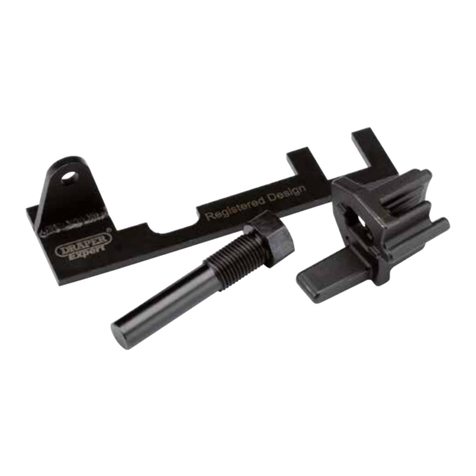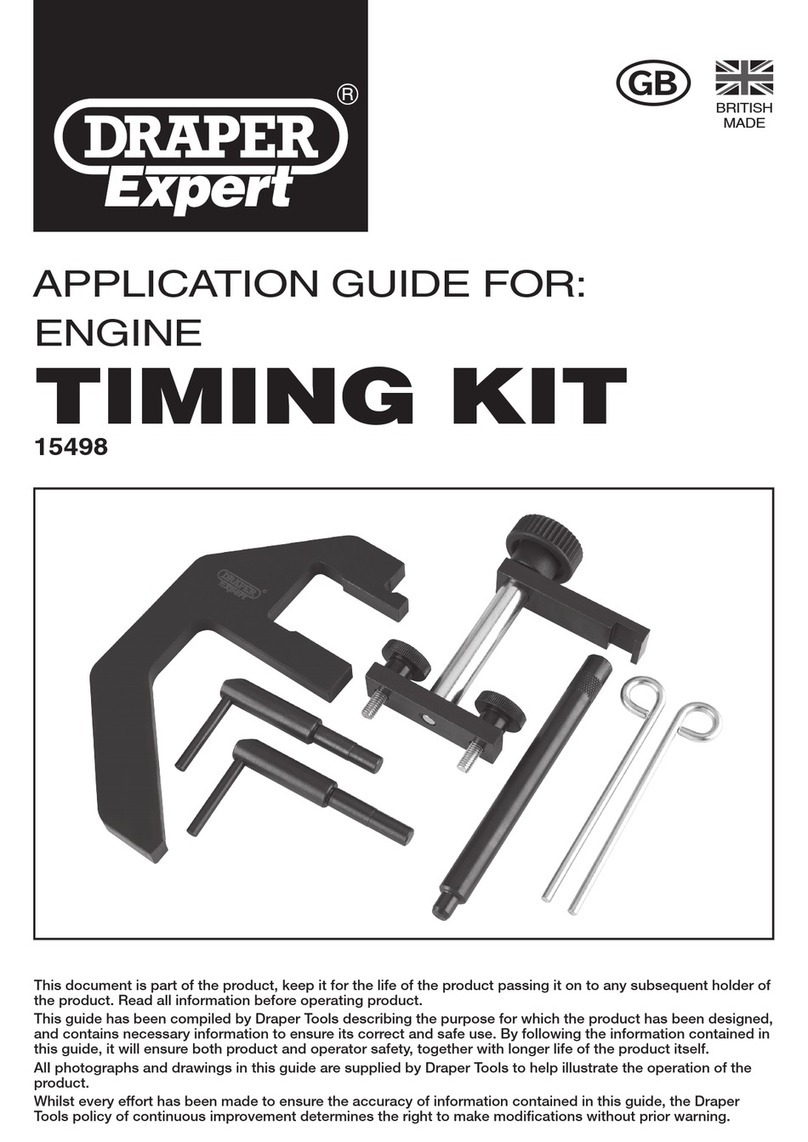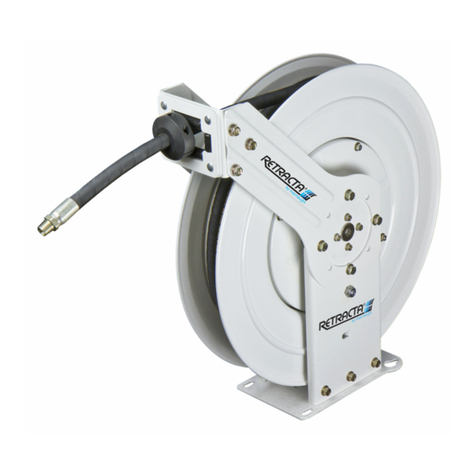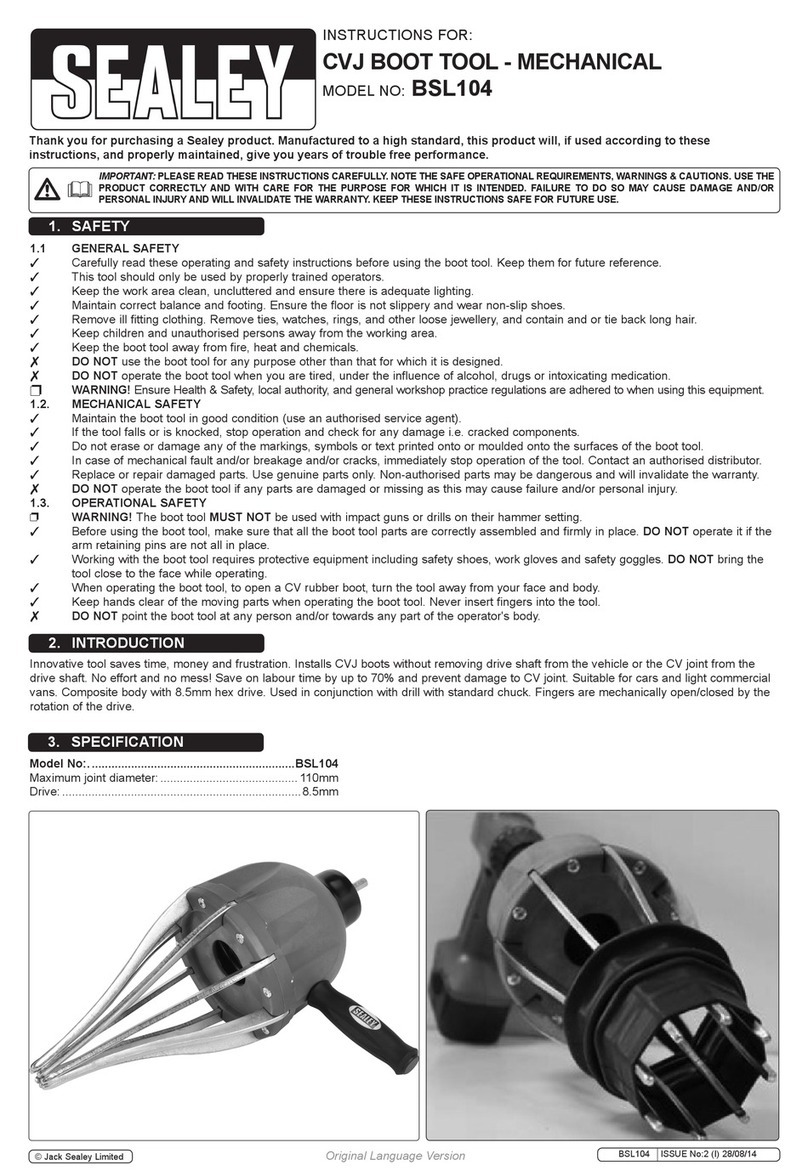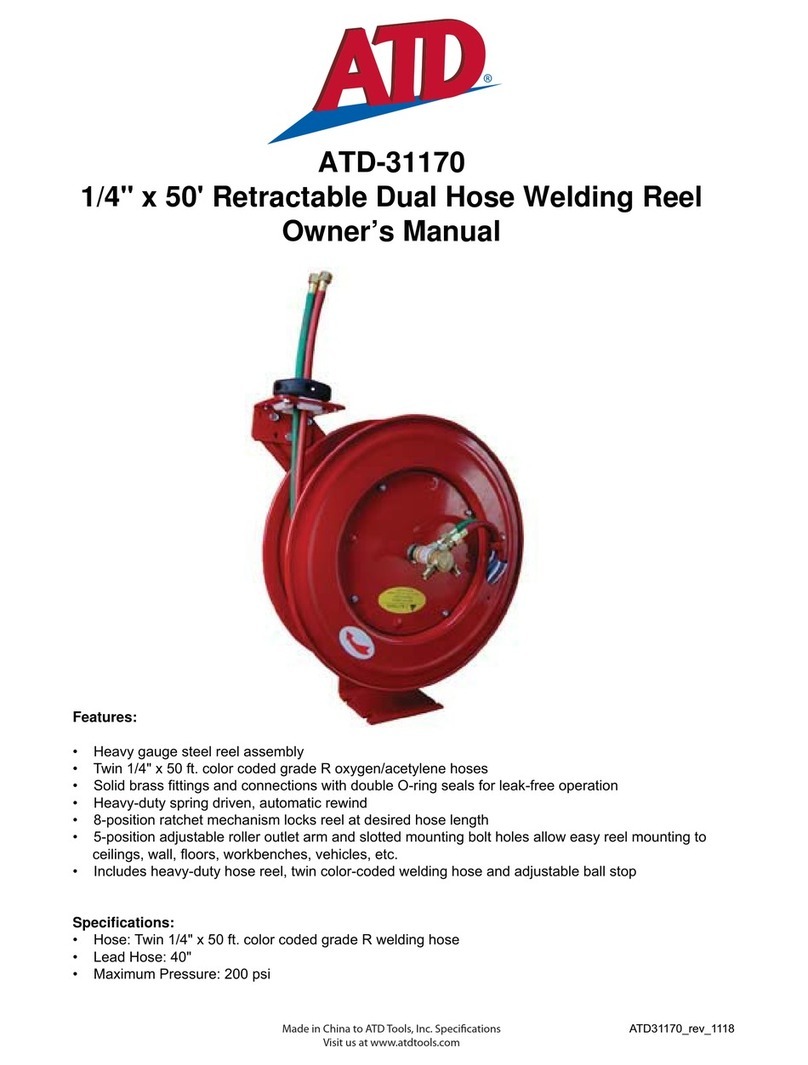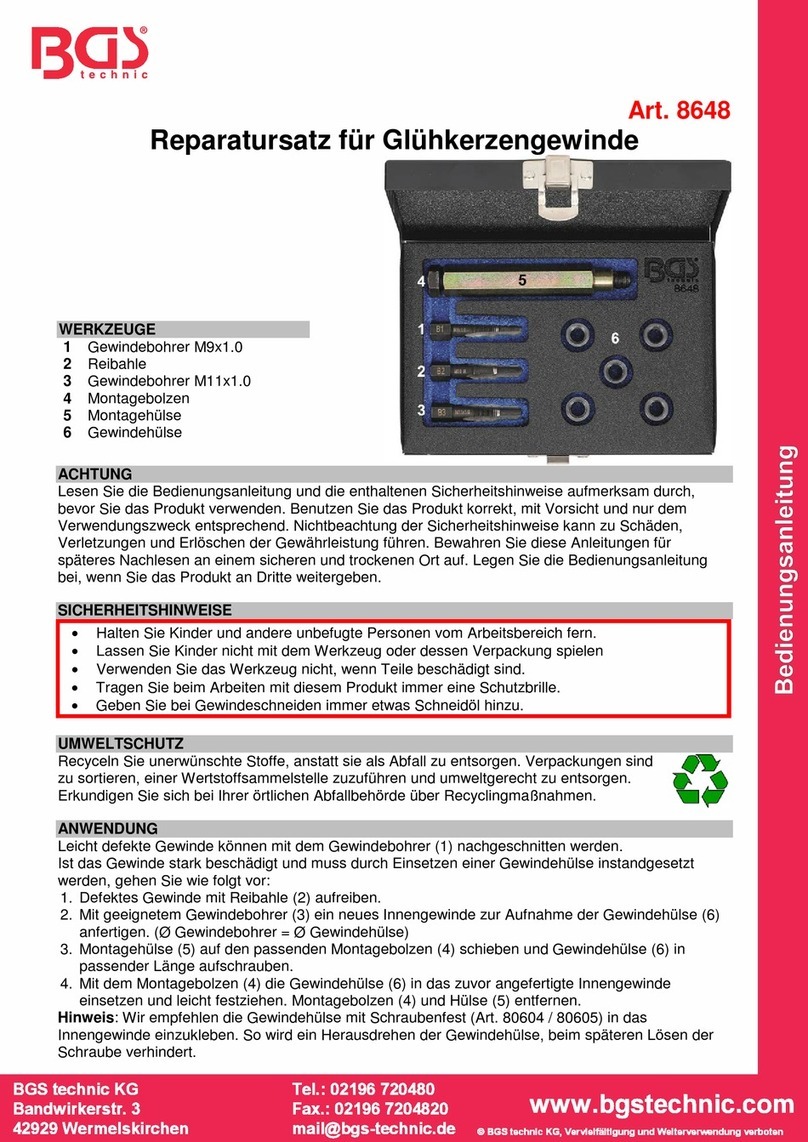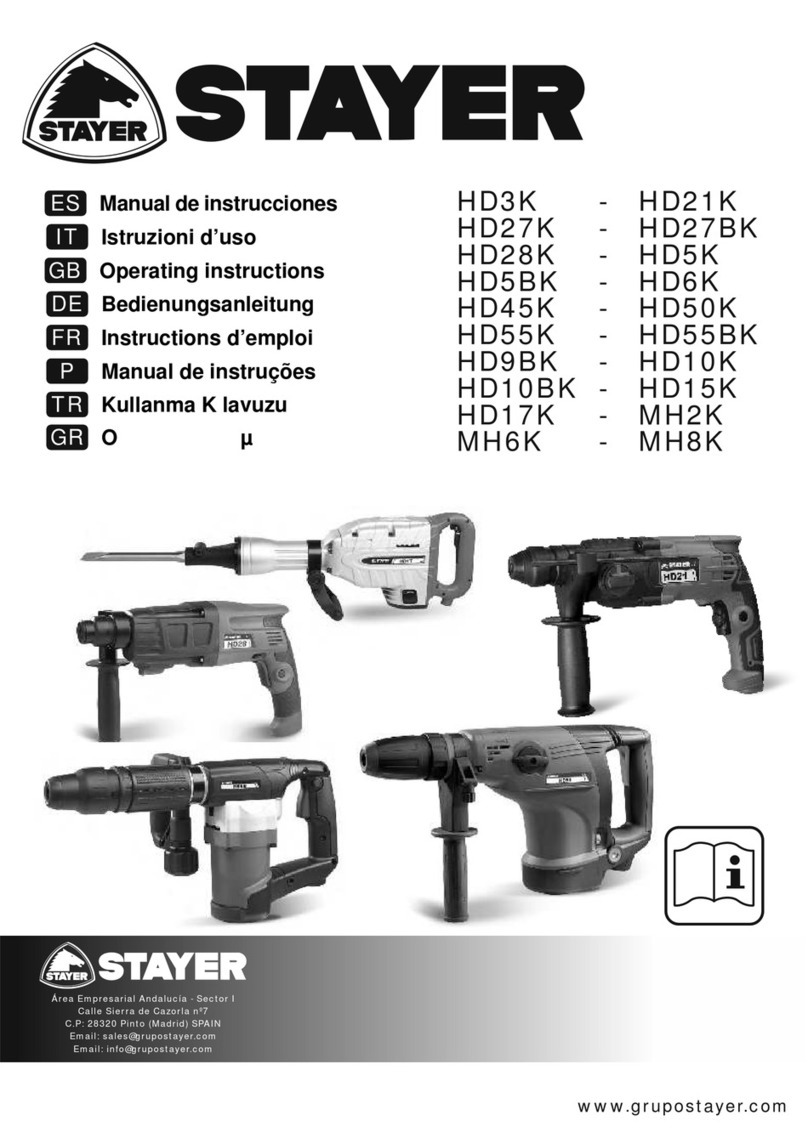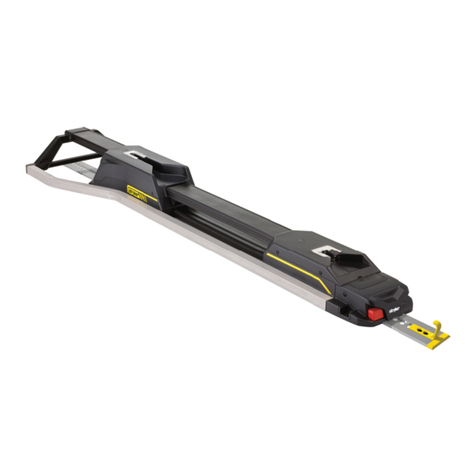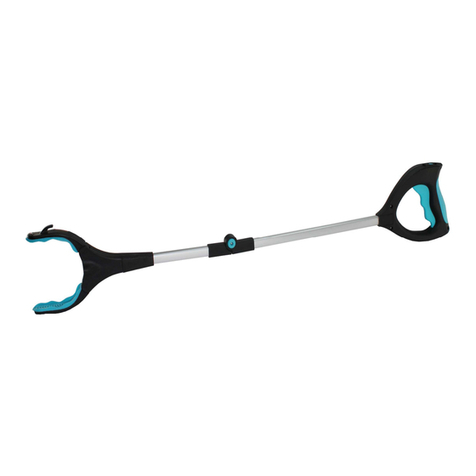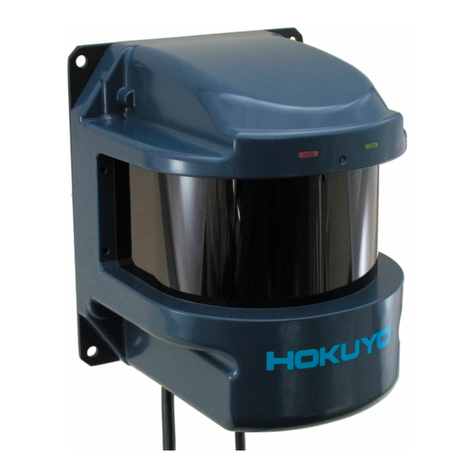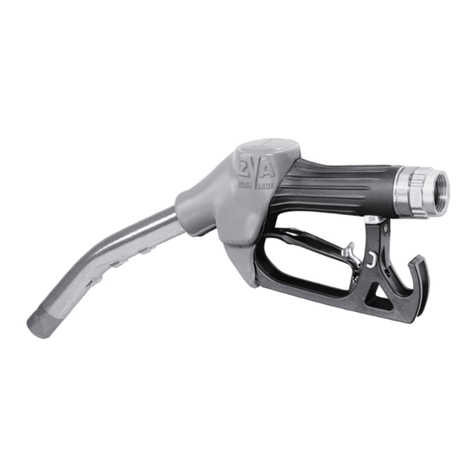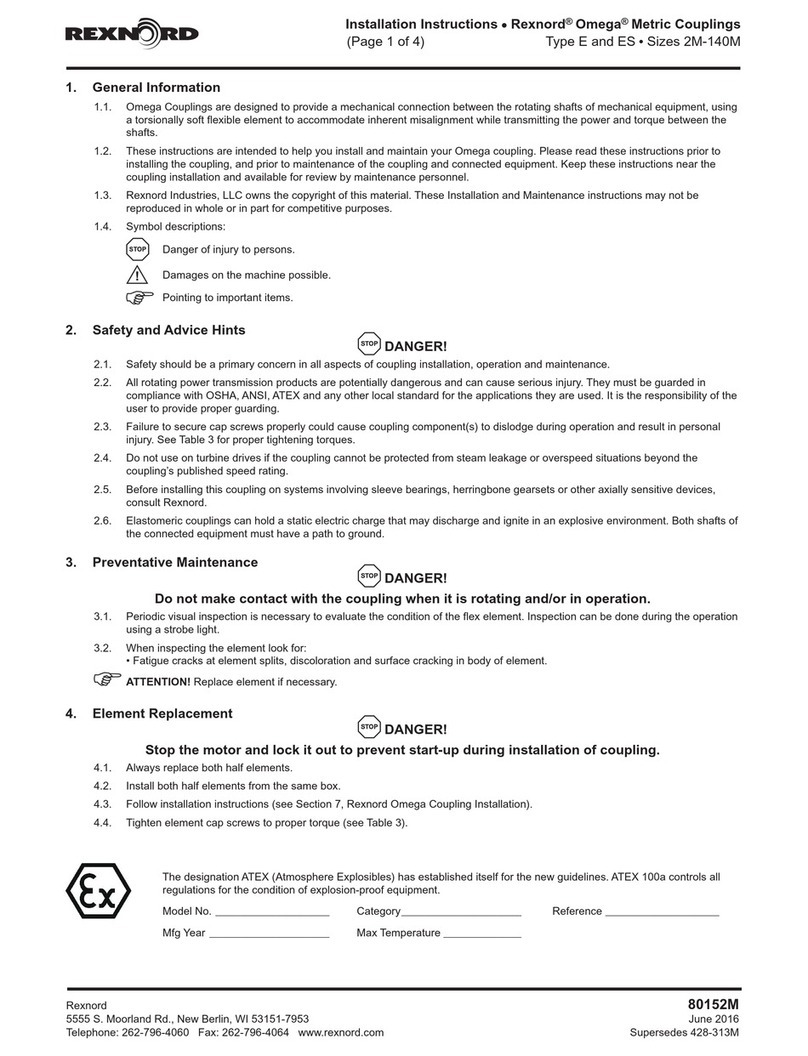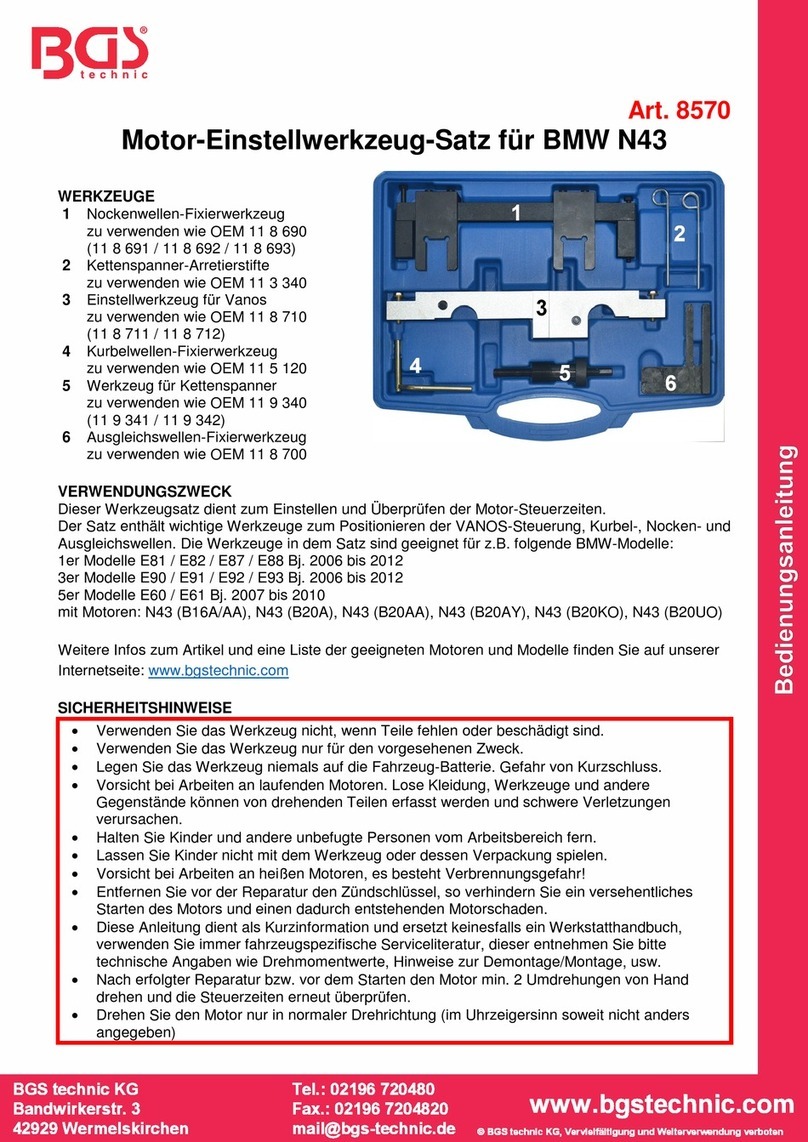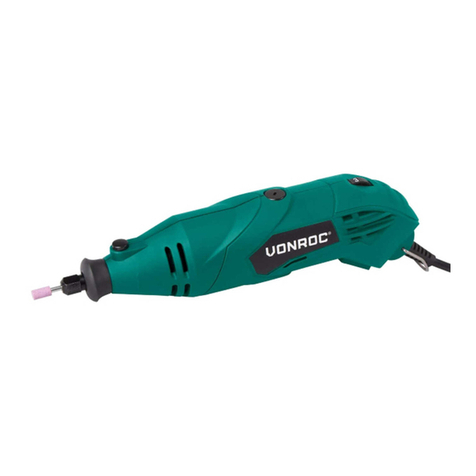Draper GPAUG52-B User manual

68294
EN
Original Instructions
Version 2
For your safety, it is essential that these instructions are read and understood in full by
the operator before attempting to assemble, operate, adjust or maintain this product.
PETROL
EARTH
AUGER KIT

1.1 Product Reference
User Manual for: Petrol Earth Auger Kit
Stock No: 68294
Part No: GPAUG52-B
1.2 Revisions
Version 1: January 2021
First release
Version 2: February 2023
General content and formatting updates
Addition of safety lanyard instructions
As our manuals are continually updated, always ensure
that the latest version is used.
Please visit drapertools.com/manuals for the latest
version of this manual and the associated parts list,
if applicable.
1.3 Understanding the Safety Content of
This Manual
WARNING!
– Situations or actions that may result
in personal injury or death.
CAUTION! – Situations or actions that may result
in damage to the product or surroundings.
Important: – Information or instructions of particular
importance.
1.4 Copyright © Notice
Copyright © Draper Tools Limited.
Permission is granted to reproduce this manual for
personal and educational use ONLY. Commercial
copying, redistribution, hiring or lending is strictly
prohibited.
No part of this manual may be stored in a retrieval system
or transmitted in any other form or means without written
permission from Draper Tools Limited.
In all cases, this copyright notice must remain intact.
1. Preface
– 2 –
These are the original product instructions. This
document is part of the product; retain it for the life
of the product, passing it on to subsequent holders.
Read this manual in full before attempting to
assemble, operate or maintain this product.
This Draper Tools manual describes the purpose
of the product and contains all the necessary
information to ensure its correct and safe use.
Following all the instructions and guidance in
this manual will ensure the safety of both the
product and the operator and increase the
lifespan of the product.
All photographs and drawings within this manual are
supplied by Draper Tools to help illustrate correct
operation of the product.
Every eort has been made to ensure the
information contained in this manual is accurate.
However, Draper Tools reserves the right to amend
this document without prior warning. Always use the
latest version of the product manual.
EN

2. Contents
– 3 –
EN
1. Preface 2
1.1 Product Reference 2
1.2 Revisions 2
1.3 Understanding the Safety Content of
This Manual 2
1.4 Copyright © Notice 2
2. Contents 3
3. Product Introduction 4
3.1 Intended Use 4
3.2 Specication 4
4. Health and Safety Information 6
4.1 General Health and Safety Precautions
for Agricultural Equipment 6
4.2 Additional Safety Information for this Tool 7
4.3 Health and Safety Information for Machines
With a Petrol Engine 8
4.4 Residual Risk 8
5. Identication and Unpacking 9
5.1 Product Overview 9
5.2 What’s in the Box? 10
5.3 Packaging 10
6. Preparation Instructions 11
6.1 Fuelling the Auger 11
6.2 Attaching the Auger Bit 13
7. Operating Instructions 14
7.1 The Safety Wrist Lanyard 14
7.2 Starting the Engine 14
7.3 Notes on Use 16
8. Maintenance and Troubleshooting 17
8.1 General Maintenance 17
8.2 Draining the Fuel 17
8.3 Air Filter Care 17
8.4 Spark Plug Care 18
8.5 Replacing the Fuel Filter 19
8.6 Storing the Product 19
8.7 Troubleshooting 21
9. Spares, Returns and Disposal 23
10. Warranty 24
11. Explanation of Symbols 25

3. Product Introduction
– 4 –
EN
3.2 Specication
Stock No. 68294
Part No. GPAUG52-B
Engine:
Type: Two-stroke
Max. performance: 1.45kW
Displacement: 52cm3
Speed at idle: 3,000min-1 (rpm)
Clutch engagement speed: 4,500min-1 (rpm)
Max. speed: 9,000min-1 (rpm)
Fuel:
Capacity: 1,200cm3(ml)
Type: E10* (RON 95) or other unleaded petrol
Oil type: Synthetic two-stroke
Fuel to oil ratio: 25:1
Bit sizes:
Diameters: 100, 150, 200mm
Length: 800mm
Noise emissions:
Sound pressure level (LpA): 91.3dB(A)
Uncertainty: 3dB(A)
Sound power level (LWA): 108dB(A)
Uncertainty: 3dB(A)
Guaranteed sound power level: 110 (dB(A)
Vibrations:
Main handle: 12.201m/s2
Auxiliary handle: 13.332m/s2
Uncertainty: 1.5m/s2
3.1 Intended Use
This product is designed to bore cylindrical holes into
soil for the purposes of fencing, bore holes and planting
hedges and saplings. This kit includes auger bits of
100mm, 150mm and 200mm in diameter. Any other
application beyond the conditions established for use
will be considered misuse. Draper Tools accepts no
responsibility for improper use of this product.
WARNING! This product is not a toy and
must be respected.
Read this manual in full before attempting to assemble,
operate or maintain the product and retain it for later use.

3. Product Introduction
– 5 –
EN
Weight:
Motor unit (no fuel): 8.9kg
100mm bit (bit only): 1.76kg
150mm bit (bit only): 2.30kg
200mm bit (bit only): 2.82kg
Important: The declared vibration total values and noise
emissions values have been measured in accordance
with a standard test method and may be used for
comparing one tool with another. These values may also
be used in a preliminary assessment of exposure.
WARNING! The vibration and noise emissions
during actual use of the product can dier from
the declared values depending on the type of
work and the material upon which it is used.
Before each use, estimate the likely exposure
resulting from the actual conditions of use.
Take into account all parts of the operation
cycle in order to identify any safety measures
required to protect the operator.
*Draper Tools recommends using an additive or stabiliser
with E10 petrol so the fuel can be safely stored in the fuel
tank for longer.

4. Health and Safety Information
– 6 –
EN
Important: Read all the Health and Safety instructions
before attempting to operate, maintain or repair this
product. Non-compliance with these instructions may
result in injury or damage to the user or the product.
4.1 General Health and Safety
Precautions for Agricultural Equipment
• Only personnel who have read and understood this
manual in full and are familiar with the operation,
safe working techniques and safety features of this
machine may operate, adjust or maintain this product.
− DO NOT allow anyone who is unfamiliar with
this product or unqualied in its use to operate
this machine.
− This machine is not intended for use by persons
with reduced physical, sensory or mental
capabilities or lack of experience and knowledge
unless they have been given supervision or
instruction in its use by a person responsible for
their safety.
− Keep this product out of reach of children at
all times.
• Observe all standard safety precautions and good
practices when working with machines and
mechanical drilling tools in an outdoor environment.
• DO NOT modify this product in any way and ONLY use
spare parts supplied by Draper Tools.
• Use this product only in the manner described in
this manual.
• ONLY use this product with the attachment tools and
accessories supplied.
− NEVER use this machine with any other tools or
accessories attached.
• Use this product only in exterior and well-ventilated
environments.
• Keep your work environment clear and well-lit,
with bystanders at a safe distance.
− Work ONLY in daylight or good articial light.
− NEVER work while children or pets are nearby.
• Before every use, inspect the product and all
accessories for broken, cracked, loose or corroded
parts and leakages.
Important: DO NOT use this product if it is damaged
or leaking in any way. Contact Draper Tools to discuss
repair and replacement options. DO NOT use
damaged or worn blades.
• DO NOT use this product if you suspect that it
has been subjected to sharp knocks or it has
been dropped.
• Ensure that all safety features are in good working
order before EVERY use.
− DO NOT use this product if any of the safety
features, including the safety lanyard, are missing
or faulty, or the machine cannot be switched on
and o using the ignition switch.
− DO NOT tamper with or disable any of the safety
systems employed by the machine.
− DO NOT operate this tool if the safety lanyard is
not connected to your person.
− ALWAYS ensure that all safety labels are visible
before use.
• Keep in mind that the operator is responsible for
accidents or hazards occurring to other people or
their property while using this machine.
• DO NOT operate this machine if you are tired or under
the inuence of alcohol, drugs or other medication.
• Be aware of your surroundings and stay alert to any
hazards that may arise that are concealed by the noise
of the machine.
• ALWAYS ensure that the machine is positioned safely
and is unobstructed when starting the engine.
• Keep a rm and secure grip on both handles
during use.
− Grip the machine by the designated insulated
areas ONLY as the bit blades may come into
contact with live wires, which may cause an
electric shock.
− Keep all handles dry and free from grease or other
substances that may cause you to lose control of
the machine.
• Keep hands, feet and other body parts away from
moving parts at all times.
• DO NOT overreach and maintain good balance while
using the tool.
• DO NOT touch the engine or exhaust during or
immediately after use.
• DO NOT leave the machine running unattended under
any circumstances.
• DO NOT refuel the machine while it is running.
• Unless an emergency occurs, reduce the throttle
during engine shut down before turning o the
ignition switch.

4. Health and Safety Information
– 7 –
EN
• Maintain the machine appropriately and correctly to
prevent damage to moving parts and mechanisms.
− Keep all attachments and xings tight to ensure
the machine is in a safe working condition.
− Replace worn or damaged parts immediately.
− Replace faulty silencers.
− Keep air vents free from dust and debris.
− ONLY have the machine serviced by authorised
and suitably qualied personnel.
• Remove all adjustment tools before use.
• DO NOT immerse this product in water or subject it to
wet conditions.
• DO NOT expose this product to frost.
• ALWAYS switch o the product, disconnect the spark
plug cover and allow the machine to completely stop
and cool before performing any adjustment,
maintenance or other inspection or transporting
the tool.
• Allow the engine to cool before storing it.
4.2 Additional Safety Information for
this Tool
• This product is suitable for drilling into soil ONLY.
NEVER attempt to drill into any other materials using
this machine.
• Wear appropriate personal protective equipment:
− Wear a protective safety helmet to protect from
projectile debris and falling materials.
− Wear safety goggles or a face shield to protect
against projectile debris.
− Wear noise-reductive ear defenders.
− Wear protective gloves.
− Wear protective knee shields.
− Wear slip-resistant protective footwear.
• In addition to personal protective equipment, dress
appropriately for the work:
− Wear durable, close-tting clothing that will not
get tangled or caught in moving parts.
− Wear substantial full-length trousers and long
sleeves.
− Keep long hair tied back and remove any long or
loose items of jewellery before use.
− DO NOT operate this machine while barefoot or
wearing sandals.
• DO NOT wield the machine in any way other than that
described in this manual.
• Operating this tool is physically demanding; maintain
good posture and balance while operating the tool
and take regular breaks to prevent injury from strain
or fatigue.
• NEVER work alone; always work in earshot of
someone who can come to your aid in the event of
an emergency.
• Thoroughly inspect the area where the tool is to be
used before operation.
− Identify any hidden objects such as wires or power
cables that may cause injury or damage if severed
by the tool.
− Identify and remove any obstructions or objects in
the intended path of the machine that might be
thrown into the air during operation.
• Operate this tool ONLY on at, level ground.
− NEVER operate this tool on sloped ground.
• NEVER operate this tool above shoulder height or on
a platform or ladder.
• Start the engine carefully, only when the required bit
has been installed and the tool is in the correct
operating position.
• Before EVERY use, test that the bit does NOT rotate
while the engine is idling.
− If the bit operates while the engine is idling,
contact Draper Tools for support.
• If the tool vibrates abnormally during use,
immediately stop the engine, allow it to cool and
investigate the cause.
− DO NOT use the tool until the issue has been
resolved.
• DO NOT allow soil to accumulate on the auger bit
blade as this will obstruct the ejection of soil from the
hole and may cause the tool to operate heavily.
• To reduce the risks associated with prolonged
exposure to vibrations through the handles, avoid
operating the machine for longer than necessary and
do not use excessive engine speeds.
• DO NOT operate the engine in conned spaces where
dangerous carbon monoxide fumes can collect.
• NEVER transport the tool between positions with the
auger bit in motion.
• NEVER drain the fuel tank inside.

4. Health and Safety Information
– 8 –
EN
• Ensure all appropriate safety precautions are
observed when transporting the machine:
− Remove the bit from the tool before
transporting it.
− When transporting the product by hand,
maintain a rm grip on both handles and keep
the machine steady.
− When transporting the product in a vehicle,
lay the tool and accessories at and strap them
securely in place.
Important: Drain all fuel and oil from the product
before transporting it in a vehicle and ensure that
all reservoir caps are tightly sealed. Keep the
transportation unit well-ventilated.
Important: ALWAYS ensure that the machine is
switched o and the spark plug cover is disconnected
during transportation.
Important: To prevent injury, ALWAYS mark and secure
holes after operation so that they are easily visible.
4.3 Health and Safety Information for
Machines With a Petrol Engine
WARNING!
Petrol is highly ammable.
• Store fuel in containers specically designed for this
purpose.
• Refuel outdoors and DO NOT smoke while refuelling.
• Replace all fuel caps securely after use.
• Add fuel before starting the engine; never remove the
cap of the fuel tank or add petrol to the machine while
the engine is running or hot.
− Take care when opening the fuel cap after use as
hot vapour may be released from the opening.
• NEVER smoke in the vicinity of the machine.
• NEVER use this product in environments where there
is a risk of explosion.
• If petrol is spilled, DO NOT attempt to start the
engine; move the machine away from the spillage area
and avoid creating any source of ignition until the
petrol vapours have dissipated.
• The engine, exhaust and fuel get hot during use.
− DO NOT touch the engine during or immediately
after use and allow it to cool before refuelling.
− ALWAYS operate the tool with the exhaust
directed away from your body.
• NEVER place objects on the engine while it is in
use and keep all air vents clear of dust, dirt and
other obstructions.
• NEVER store the machine with fuel in the tank inside
any structure where petrol fumes could reach an open
ame or spark.
• To reduce the risk of re, keep the engine, silencer
and petrol storage area free from vegetation and
excessive grease.
WARNING! The machine exhaust emits toxic
carbon monoxide: a colourless, odourless gas.
Breathing exhaust fumes can cause loss of
consciousness, permanent respiratory damage
and eventually death. ONLY operate this machine
in a well-ventilated outdoor environment.
Important: E10 petrol is hygroscopic and attracts
moisture. Read all the preparation and maintenance
information relating to E10 fuel before using it in this
machine. Draper Tools recommends using an additive or
stabiliser with E10 petrol to extend the period that it can
be safely stored in the fuel tank. ALWAYS read the label
of any additive or stabiliser applied.
4.4 Residual Risk
The safety instructions in this manual cannot account for
all possible conditions and situations that may occur.
Exercise common sense and caution when using this
product and protect against any additional conceivable
risks.

5. Identication and Unpacking
5.1 Product Overview
– 9 –
EN
(1) Air lter cover
(2) Auger bit
(3) Carburettor
(4) Choke lever
(5) Connection pin
(6) Drive shaft
(7) Exhaust
(8) Fuel tank
(9) Fuel tank cap
(10) Handlebars
(11) Ignition switch
(12) Lanyard activation point
(13) Pilot drill
(14) Priming bulb
(15) Recoil starter
(16) Safety wrist lanyard
(17) Spark plug cover
(18) Throttle lever
(1)
(3)
(2)
(7)
(4)
(17)
(18)
(5)
(9)
(14)
(18)
(10)
(16)
(11)
(12)
(15)
(13)
(8)
(6)

5. Identication and Unpacking
Please visit drapertools.com for our full range of accessories and consumables.
– 10 –
EN
5.3 Packaging
Keep the product packaging for the duration of the
warranty period for reference should the product need to
be returned for repair.
WARNING! Keep packaging materials out of
reach of children. Dispose of packaging
correctly and responsibly and in accordance
with local regulations.
(A) 1 x Engine unit
(B) 1 x Ø 200mm bit
(C) 1 x Ø 150mm bit
(D) 1 x Ø 100mm bit
(E) 1 x Two-stroke mixing bottle
(F) 1 x Funnel
(G) 1 x Spanner driver
(G1) 19mm (M12) box spanner
(G2) 17mm (M10) box spanner
(G3) PH-type screwdriver
(H) 1 x Combination spanner
(H1) 10mm (M6) spanner
(H2) 8mm (M5) spanner
(I) 1 x 5mm hex key
(J) 1 x 4mm hex key
(K) 1 x Tool bag
5.2 What’s in the Box?
Carefully remove the product from the packaging and
examine it for any signs of damage that may have
occurred during shipment.
Before assembling the product, lay the contents out and
check them against the parts shown below. If any part is
damaged or missing, do not attempt to use the product.
Please contact the Draper Helpline; contact details can
be found at the back of this manual.
(A)
(B)
(C)
(D)
(E)
(F)
(H)
(H2)
(G3)
(H1)
(G2)(G1)
(J) (I)
(G)
(K)

– 11 –
EN
6. Preparation Instructions
Important: Read all the Health and Safety guidance for
use of petrol as a fuel before lling or otherwise
preparing this product.
6.1 Fuelling the Auger
CAUTION! This machine is shipped WITHOUT
fuel. Check the fuel level before EVERY use and
top up as appropriate. NEVER attempt to run the
engine on an empty fuel tank.
Important: ALWAYS ensure that the correct type and
mixture of fuel and oil is used. Damage caused by failure
to add fuel or by the use of incorrect or poor-quality fuel
is not covered by your warranty.
The engine on this machine requires a mixture of petrol
and oil to run. The mixture must contain the following
components and quantities:
Component Quantity Notes
Petrol 25 parts Only use fresh, clean and
good-quality unleaded
automotive petrol.
Oil 1 part Only use high-quality
two-stroke synthetic oil.
DO NOT use any other type
of oil, including engine oil,
as this will permanently
damage the engine.
ALWAYS use automotive petrol. Draper Tools
recommends E10 (95 RON) automotive fuel,
with an appropriate additive or stabiliser, for use
with this product.
CAUTION! E10 petrol is hygroscopic and
attracts moisture, which may damage the
fuel system if stored in the product for more
than four weeks. See Using E10 Petrol below
for guidance.
WARNING! ALWAYS mix fuel in a well-ventilated
area away from sources of ignition. Store fuel
only for short periods, away from direct
sunlight and heat sources, and only in
containers specically designed for that
purpose. Avoid prolonged contact with the
skin and inhalation of petrol vapour.
Important: The engine unit MUST be in an upright
position when fuel is added.
To fuel the machine:
1. Disconnect the spark plug cover (17).
1 Fig.
2. Mix the fuel and oil:
2 Fig.
a. Holding the two-stroke mixing bottle with the
25:1 marking (19) visible, remove the bottle fuel
cap (20).
b. Pour unleaded petrol through the fuel cap opening
until the 10 level mark on the main reservoir (21)
is reached.
c. Remove the bottle oil cap (22) and pour two-stroke
oil through the opening until the 10 level mark on
the ancillary reservoir (23) is reached.
d. Ensure that both caps are tightly tted and tip the
mixing bottle to allow all of the oil to run into the
main reservoir through the openings at the top of
the bottle (24).
e. Shake the bottle gently to thoroughly mix the fuel
and oil.
(17)
25.1
10
(19)
(23)
(22) (20)
(21)
55
10
(24)
Fill fuel
to here
Fill oil
to here

– 12 –
EN
6. Preparation Instructions
CAUTION! ALWAYS use the 25:1 scale on the
ancillary reservoir to measure the oil. Using the
incorrect mixture may cause permanent damage
to the engine. Damage caused in this manner is
not covered by your warranty.
Important: Only mix as much fuel as is necessary
for the operation as fuel quality degrades rapidly.
When measuring dierent amounts of fuel, ll the
ancillary reservoir with oil to the corresponding
level mark.
3. Twist the fuel tank cap (9) anticlockwise to remove it
and allow it to hang clear of the opening.
WARNING! If the tool has been recently used,
hot steam may vent from the fuel tank outlet.
Take care when opening the fuel tank.
4. Using the funnel (F), carefully pour the fuel mixture
into the fuel tank so that the level is just below the
ller neck.
The fuel tank should accommodate a little more than
one full mixture from the two-stroke mixing bottle.
3 Fig.
CAUTION! DO NOT overll the fuel tank as this
may damage the engine. NEVER allow dust,
dirt, water or dirty fuel to enter the fuel tank.
Clean up any spillages IMMEDIATELY.
5. Reattach the fuel cap, ensuring it is properly tted
and securely tightened.
6. Reconnect the spark plug cover when the machine is
ready for use.
A 25:1 ratio can alternatively be considered as adding
40ml of oil to 1L of fuel.
Using E10 Petrol
All Draper petrol products are compatible with E10
petrol. However, due to the increased ethanol level,
E10 petrol is hygroscopic: this means that it attracts and
mixes with water from the air, which accumulates in the
engine and the petrol deteriorates more quickly. If E10
petrol is stored in a machine’s fuel tank for extended
periods, this build-up of water can form a corrosive gum
that rusts the fuel system from the inside.
Draper Tools recommends the use of petrol additives or
stabilisers when using E10 petrol. Additives and
stabilisers are widely available and can extend the length
of time that E10 petrol can be safely stored in a product
fuel tank.
The impact of additives or stabilisers on the lifespan of
the fuel varies with each product and will deteriorate over
time – always read the label. E10 petrol should not
remain in the fuel tank for more than four weeks without
an additive or stabiliser.
Even where additives or stabilisers are used, Draper Tools
recommends that E10 fuel is drained from the fuel tank
every three to four weeks to reduce the risk of damage to
the product. The fuel must be drained from the fuel tank
within the time limit specied by any additives or
stabilisers added to the fuel. If the machine will not be
used for longer than this time, drain it before putting it
into storage.
After draining the fuel tank, always run the engine until
the last of the fuel in the system is spent and drain the
oat bowl when the engine is cool.
E10 petrol should be used within 30 days of purchase.
Some petrol brands contain other quantities of ethanol.
DO NOT use fuels with more than 10% ethanol in
Draper products.
Always store and dispose of fuels responsibly and in
accordance with local regulations.
(9)
(F)

– 13 –
EN
6. Preparation Instructions
6.2 Attaching the Auger Bit
Important: DO NOT connect any auger bit to this tool
that has not been supplied with this product. Other auger
bits may be unsuitable for the engine or t incorrectly
and result in injury or cause damage to the tool.
WARNING! Never use an auger bit if the
R-pin or locking bar is missing, damaged or
signicantly corroded.
1. Remove the R-pin (25) from the locking bar (26) and
slide the locking bar away from the auger bit.
4 Fig.
2. Install the auger bit onto the engine unit drive shaft
(6) and align the holes.
5 Fig.
3. Insert the locking pin and secure it in place with
the R-pin.
4. Pull outwards on the auger bit to ensure that it is
securely held in place.
(25)(26)
(6)

– 14 –
EN
7. Operating Instructions
Important: Before operating this product, read and
understand all the safety instructions listed in
this manual.
WARNING! DO NOT start the machine until the
auger bit and safety lanyard have been installed.
This machine must be operated with both hands
(one on each handle) at all times.
WARNING! Using this tool can pose a danger to
wildlife. Before attempting to use the auger,
check the area – particularly in long grass and
under bushes – for signs of life and responsibly
relocate any creatures found there if necessary.
Not all wildlife will be deterred by the noise of
this machine alone.
7.1 The Safety Wrist Lanyard
The safety wrist lanyard (16) must be installed in order to
use this product and acts as a safety cut-o should you
lose control of the tool.
WARNING! DO NOT use this tool if the safety
wrist lanyard is damaged or weakened. If the
lanyard cord breaks, it will not cut power to
the engine.
6 Fig.
The lanyard is pre-installed onto the engine unit before
shipment. If it has been removed, push the cup end of the
lanyard rmly onto the lanyard activation point (12).
Wrap the other end of the lanyard around your wrist and
use the clip to secure it. If you lose your grip on the tool
during operation, the lanyard cup will be pulled from the
engine unit and stop the tool, allowing you to regain
control safely.
Important: If the safety wrist lanyard is not installed,
the auger will NOT operate.
7.2 Starting the Engine
CAUTION! This machine is NOT shipped with
fuel or oil. DO NOT attempt to start the engine
until an appropriate mix of fuel and oil has been
added to the tool.
WARNING! DO NOT start this tool until the
appropriate auger bit has been securely
installed. Read all the safety and operation
instructions in this manual before use.
Important: DO NOT start the machine until it is in
its operating position at the location to be drilled.
NEVER travel with the machine switched on.
WARNING! DO NOT start this tool unless the
safety wrist lanyard is correctly installed onto
the engine unit and is secured around your
wrist. Failure to connect the lanyard to your
person disables one of the safety features of
this tool and is prohibited.
Performing a Cold Start
1. Ensure that the spark plug cover (17) is
connected and move the ignition switch (11) into
the on ( I ) position.
7 Fig.
(11)
(16)
(12)

– 15 –
EN
7. Operating Instructions
2. Slide the choke lever (4) to the closed ( ) position.
8 Fig.
3. Press the priming bulb around six times until fuel can
be see owing through the clear hose from the fuel
tank (8) to the carburettor (3).
9 Fig.
CAUTION! Over-priming the engine will cause it
to be ooded with too much fuel, which may
immerse the spark plug and prevent the engine
from starting. The engine will smell strongly of
fuel if this occurs.
4. Slowly pull on the recoil starter (15) until resistance is
felt, then pull it out rapidly.
10 Fig.
CAUTION! DO NOT attempt to start the engine
when the recoil starter is fully retracted.
DO NOT allow the recoil starter to snap back
against the engine. Return it gently to prevent
damage to the starter.
5. Do this several times until the engine starts.
6. Allow the engine to run for a few seconds, then open
the choke slightly.
7. After a further few seconds, move the choke lever
fully to the open ( ) position.
8. Gently press the throttle lever (18) to engage the drive
shaft, then increase pressure on the throttle lever to
start the operation.
Performing a Warm Start
1. Ensure that the spark plug cover (17) is
connected and move the ignition switch (11) into
the on ( I ) position.
11 Fig.
(8)
(3)
(11)
(15)
(4)

– 16 –
EN
7. Operating Instructions
2. Slide the choke lever (4) to the open ( ) position.
12 Fig.
3. Slowly pull on the recoil starter (15) until resistance is
felt, then pull it out rapidly.
13 Fig.
CAUTION! DO NOT attempt to start the engine
when the recoil starter is fully retracted.
DO NOT allow the recoil starter to snap back
against the engine. Return it gently to prevent
damage to the starter.
4. Do this several times until the engine starts.
If the engine does not start after the fth attempt
during a warm start, attempt a cold start.
5. Allow a few seconds for the engine to reach its
working temperature, then gently press the throttle
lever (18) to engage the drive shaft.
6. Increase pressure on the throttle lever to begin the
operation.
Important: If the auger bit rotates while the engine is
idling, switch o the engine immediately and contact
Draper Tools for support.
CAUTION! The internal components of the
engine will undergo a bedding-in period during
the rst few uses.
For the rst six tanks of fuel, avoid running the
engine at high revolutions as the stress during this
bedding-in period may cause damage to the
engine. The clutch may also slip more frequently
during this period.
7.3 Notes on Use
During operation, hold the earth auger in a vertical
position and grip it rmly with both hands at all times.
Stand comfortably with your legs slightly apart and the
auger centrally in front of you to maintain a stable and
well-balanced position. Ensure that your legs and body
stay clear of the drilling area.
Position the auger engine unit so that the exhaust (7) is
directed away from you. This also ensures that, should
the auger bit catch in the soil, the engine recoil will pull
the throttle lever out of your grip and the bit will stop
turning. Brace yourself against sudden recoil caused by
contact with hidden rocks, roots and other debris
beneath the surface.
Apply rm downward pressure onto the handlebars
throughout the operation, but DO NOT force the tool;
let the tool do the work.
Draper Tools recommends beginning the operation
using half-throttle speed and gradually increasing
pressure on the throttle lever (18), particularly when
boring deeper holes.
Important: ALWAYS mark and secure holes after
operation so that they are easily visible to prevent injury
to others.
(15)
(4)

– 17 –
EN
Important: Maintenance and repairs should be carried
out ONLY by authorised and suitably qualied personnel.
WARNING! ALWAYS switch o the engine,
disconnect the spark plug cover and allow the
machine to cool before maintaining this
product. Remove any auger bit from the engine
unit before performing any maintenance.
WARNING! If the engine must be run for testing,
ensure that this is carried out in a well-ventilated
environment that allows carbon monoxide from
the exhaust to dissipate quickly.
Regular and thorough maintenance will contribute to an
extended life of the product. Poor maintenance can lead
to reduced performance and rapid deterioration of the
engine and blades.
8.1 General Maintenance
• Keep all air vents clean and free from obstructions at
all times.
• Clean the machine with a damp cloth ONLY.
Important: DO NOT use solvents as this may damage
the plastic parts of the machine.
• Use ONLY spare parts supplied by Draper Tools.
• Keep all auger bits free from debris and clean them
after every use.
− Wear protective gloves while maintaining the
auger bits.
− Use a brush or other tool to remove debris from
cutting parts; NEVER use your bare hands.
• Replace auger bits when they became damaged or
excessively worn.
8.2 Draining the Fuel
Important: Read all the Health and Safety guidance
for the use of petrol as a fuel before lling or draining
this product.
WARNING!
NEVER drain the fuel tank indoors.
1. Ensure that the ignition switch (11) is in the
o ( ) position and the spark plug cover (17)
is disconnected.
2. Remove the fuel tank cap (9) slowly and tip the
engine unit backwards to allow the fuel to drain
into a suitable container.
WARNING! If the tool has been recently used,
hot steam may vent from the fuel tank outlet.
Take care when opening the fuel tank.
3. Reattach the fuel tank cap securely and wipe up
any spillages.
4. Reconnect the spark plug cover and start the engine;
see 7.2 Starting the Engine.
5. Allow the engine to run until it cuts out; this exhausts
any fuel remaining in the carburettor.
8.3 Air Filter Care
Clean the air lter chamber and element regularly
to ensure consistent airow into the carburettor.
Increase the frequency of cleaning when working in
dusty environments.
WARNING! NEVER use petrol or solvents to
clean the air lter elements as this may result in
a re when the machine is next used.
CAUTION! NEVER run the machine without the
air lter elements in place as this may cause the
engine to degrade rapidly.
1. Ensure that the choke lever (4) is in the closed
position to prevent any debris from entering
the carburettor.
2. Use the 4mm hex key (J) to loosen and remove the
socket bolt (27) and washers that secure the air lter
cover (1) in place.
14 Fig.
Important: Ensure that the washer and spring washer
remain in the correct positions on the bolt.
8. Maintenance and Troubleshooting
(J)
(27)
(1)

– 18 –
EN
3. Open the air lter housing and remove the foam
element; check it for holes, tears and obstructions.
15 Fig.
Important: If the foam element is damaged, replace it
with a new one. DO NOT use the machine if the air
lter is damaged.
4. Wash the element in warm soapy water and
allow it to dry thoroughly.
Important: DO NOT use solvents to clean
the element.
5. Clean the compartment and covers of any dust,
dirt or other obstructions.
6. Reassemble the air lter and screw in the socket bolt
and washers to secure the housing back in place.
8.4 Spark Plug Care
Ensure that the spark plug is clean and correctly gapped.
The spark plug may become contaminated over time if
the machine is run with part-throttle for prolonged
periods or the fuel mixture contains too much oil.
Important: Replace the spark plug after every 60 hours
of use or at least once a year. ONLY use L7TC or similar
compatible spark plugs with the same heat range.
1. Remove the spark plug cover (17).
16 Fig.
Important: DO NOT use tools to remove the cover as
it may damage the HT lead.
2. Use the M12 box spanner (G1) to loosen and remove
the spark plug from the socket.
17 Fig.
3. Visually inspect the spark plug and replace it if the
ceramic insulator is cracked or chipped.
4. Measure the spark plug gap using a feeler gauge
(not supplied) and correct as appropriate by gently
bending the electrode into position.
Important: The gap should be 0.6–0.7mm.
8. Maintenance and Troubleshooting
(G1)
(17)

– 19 –
EN
8. Maintenance and Troubleshooting
5. Attach the spark plug washer and thread the plug into
place by hand.
Important: If mounting a new spark plug, use the
spark plug wrench to screw the spark plug an
additional half rotation after hand-tightening to the
point that the washer is compressed. If mounting an
old spark plug, screw no more than up to an
additional quarter rotation as appropriate.
6. Replace the spark plug cover securely.
CAUTION! The spark plug MUST be securely
tightened. Loose spark plugs can become very
hot and cause damage to the engine. NEVER use
a spark plug with a heat range that is not
appropriate for the machine in which it is used.
8.5 Replacing the Fuel Filter
A small fuel lter is installed inside the fuel tank (8) to
ensure that the feed of fuel into the carburettor remains
clean. This lter must be checked regularly and replaced
when it becomes clogged.
Important: Wear protective gloves to protect your hands
from the fuel.
1. Completely drain the fuel from the fuel tank;
see 8.2 Draining the Fuel.
2. Gently pull on the fuel tank cap (9) to draw the spring
clip out of the tank.
18 Fig.
3. Tilt the engine so that the fuel tank opening is at the
lowest point and rmly shake the unit to allow the
lter to fall within reach.
If the lter does not fall towards the opening, the fuel
pickup line can be manoeuvred by reaching inside
the fuel tank.
Important: Be wary of dripping fuel when reaching
inside the fuel tank to remove the lter.
4. Gently pull the lter out of the fuel tank opening.
19 Fig.
5. Without letting go of the fuel pickup line (28),
detach the lter from the end of the tube.
6. While still holding the fuel pickup line, insert a
new lter onto the tube and insert it back into the
fuel tank.
7. Push the cap spring clip back into the fuel tank and
tighten the cap in place.
8.6 Storing the Product
Important: ALWAYS ensure that the engine has
completely cooled before storing the machine.
• Prepare the machine correctly for storage:
− Ensure that the ignition switch is in the
o ( ) position.
− Disconnect the spark plug cover (17).
− Drain the fuel (see 8.2).
− Remove, clean and dry the auger bits.
− Tighten all reservoir caps and leakage points.
− Cover the machine with a plastic sheet to protect
it against dust and moisture.
• Store the machine and attachments in a dry and
dust-free environment, out of reach of children.
• Store the machine at a temperature of 0–30°.
• Start the engine at periodic intervals to prevent
seizure within the engine and driveshaft.
(28)
(9)

– 20 –
EN
8. Maintenance and Troubleshooting
If the machine is to be stored for a prolonged period,
ensure that the engine cylinder is suciently lubricated
to prevent it from seizing:
1. Remove the spark plug; see 8.4 Spark Plug Care.
2. Pour a few drops of SAE 5W-30 oil into the socket.
3. Pull the recoil starter (15) slowly to distribute the oil.
4. Return the spark plug securely to the socket.
5. When restarting after storage:
a. Remove the spark plug.
b. Hold a cloth around the spark plug socket opening.
Important: DO NOT smother or completely cover
the opening.
c. Pull on the recoil starter several times and
catch any ejected oil using the cloth.
Do this until no more oil is ejected from
the opening.
d. Return the spark plug securely to the socket
e. Start the engine in the usual way;
see 7.2 Starting the Engine.
Other manuals for GPAUG52-B
1
This manual suits for next models
1
Table of contents
Other Draper Tools manuals
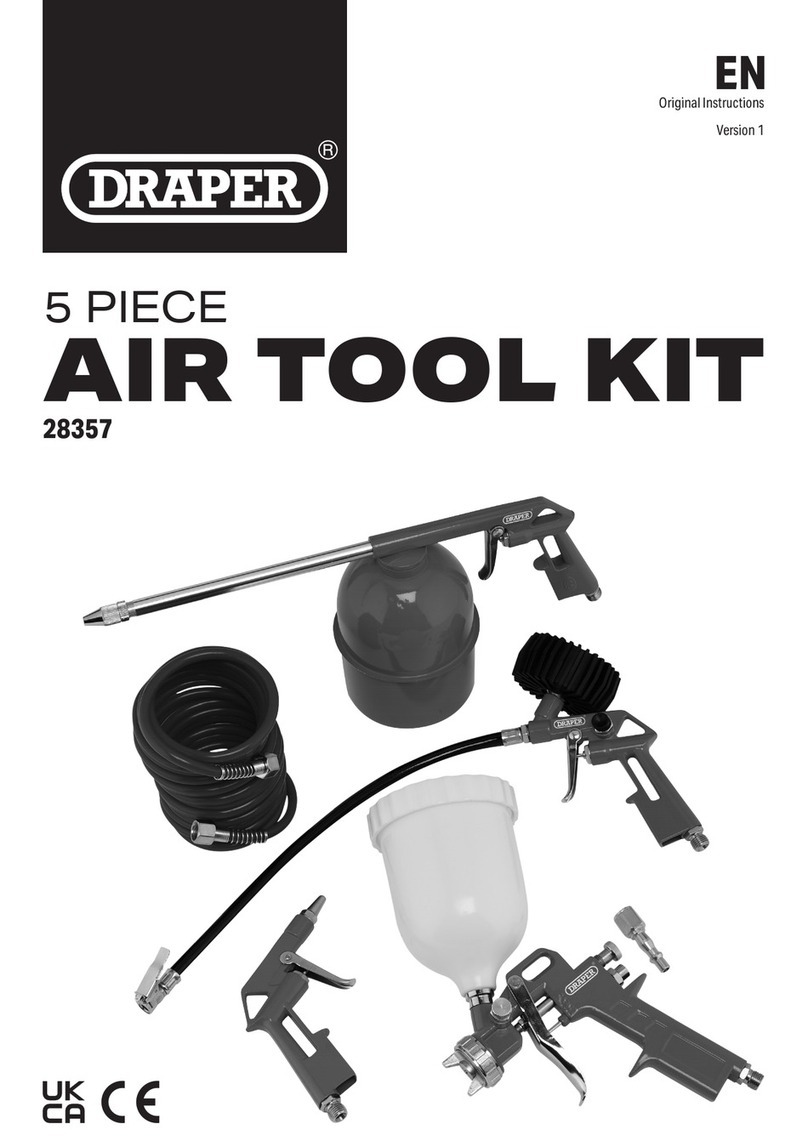
Draper
Draper 28357 User manual
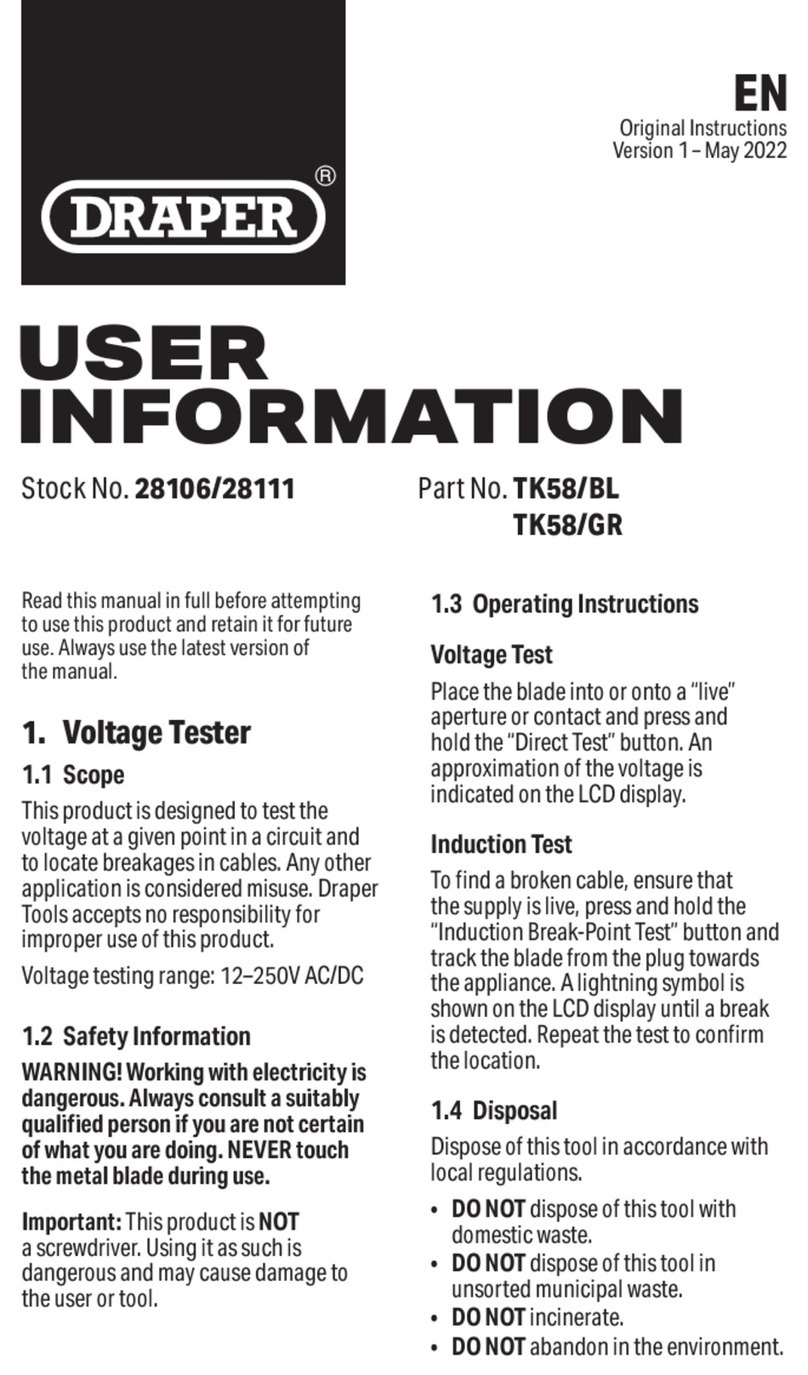
Draper
Draper TK58/BL Operation manual
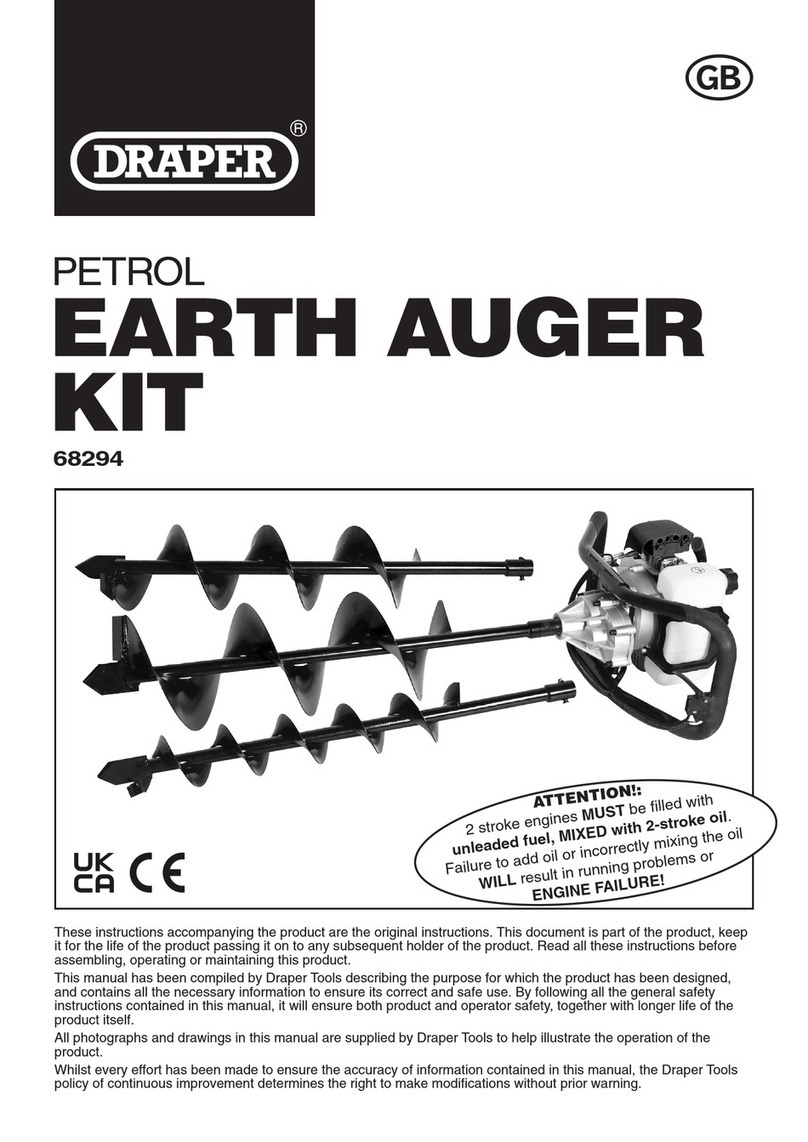
Draper
Draper GPAUG52-B User manual

Draper
Draper Storm Force SFAH4 User manual
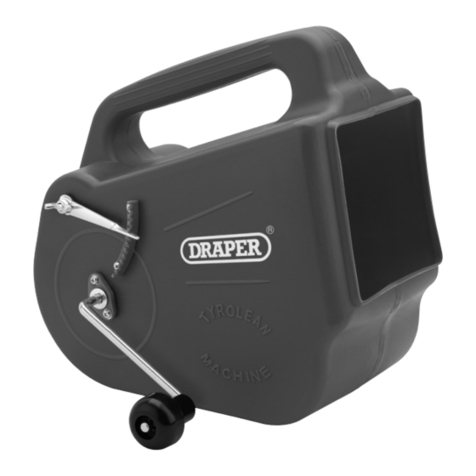
Draper
Draper PTF User manual

Draper
Draper 98421 User manual

Draper
Draper 18745 User guide
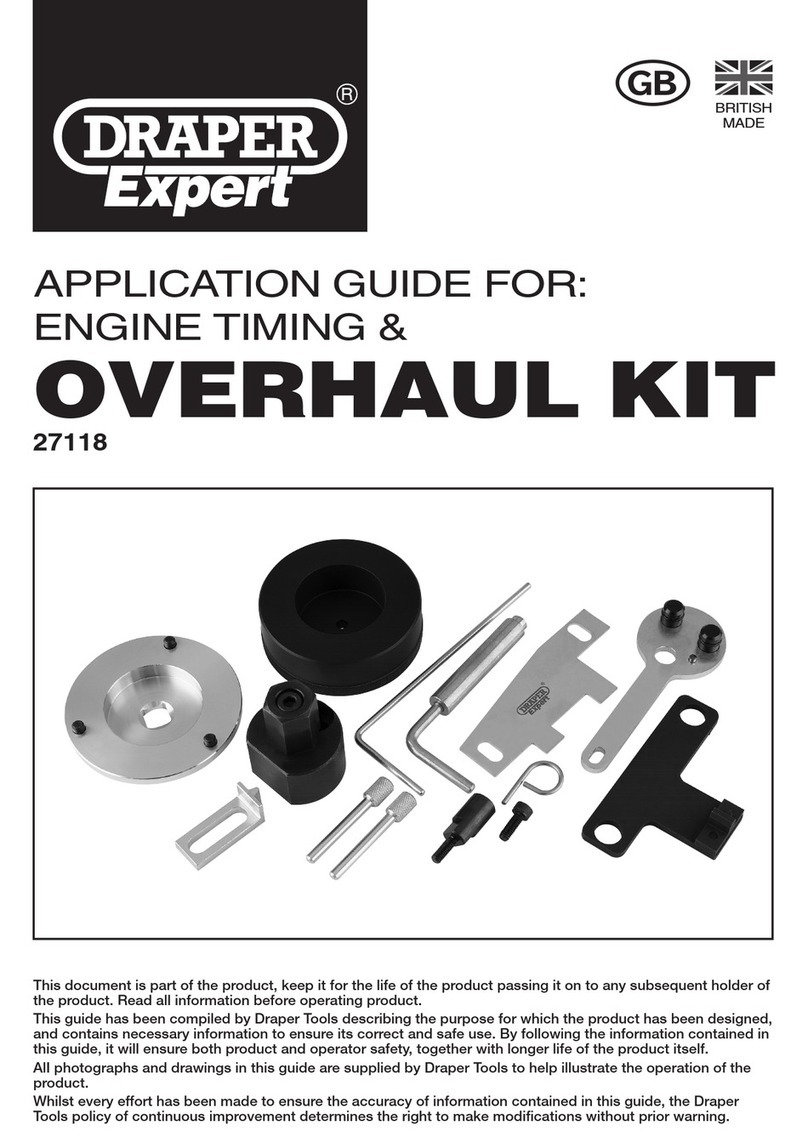
Draper
Draper 27118 User guide
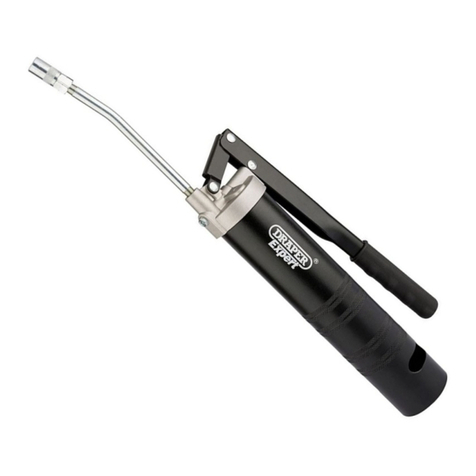
Draper
Draper A10/EXP/F User manual

Draper
Draper 23313 User manual
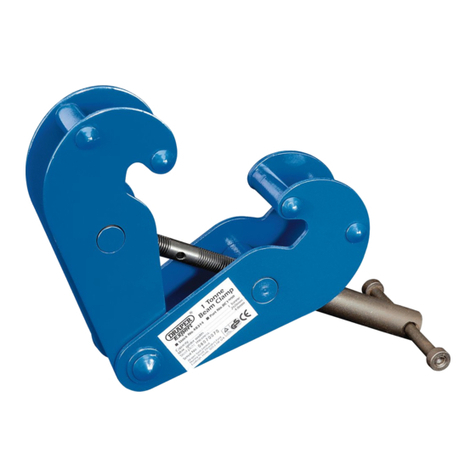
Draper
Draper BC1000 User manual

Draper
Draper PT2000D User manual
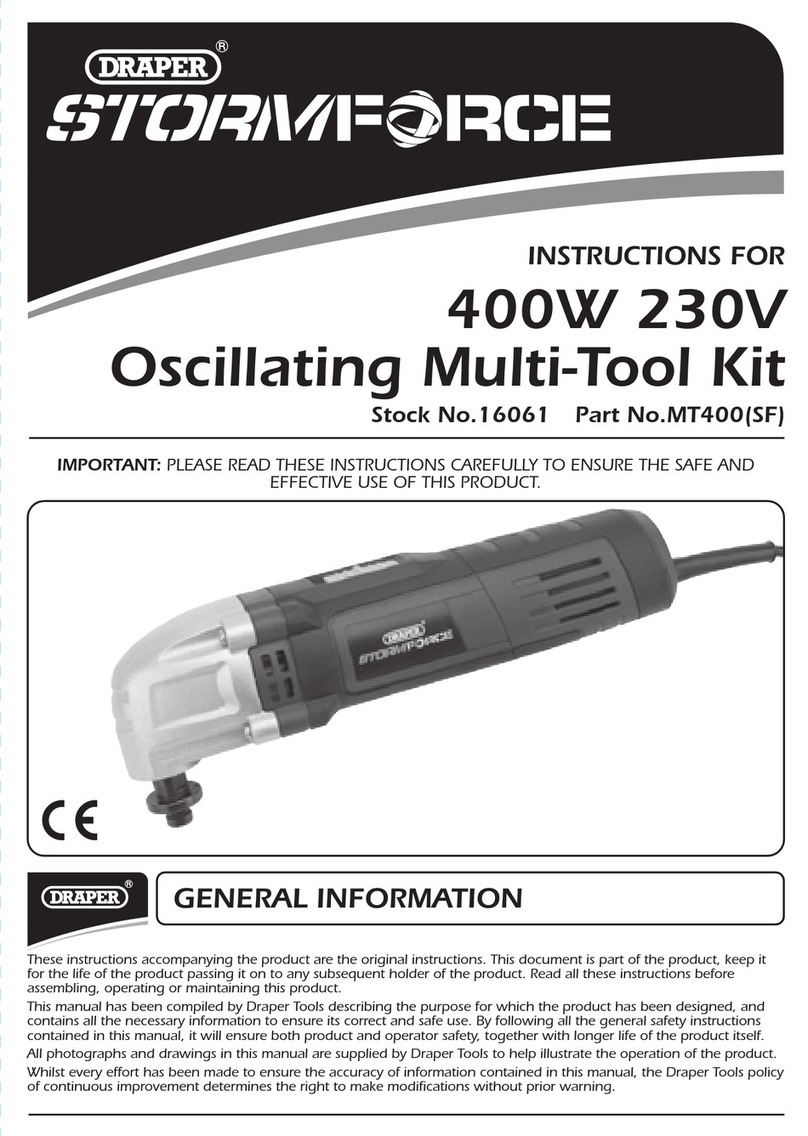
Draper
Draper STORMFORCE MT400 User manual
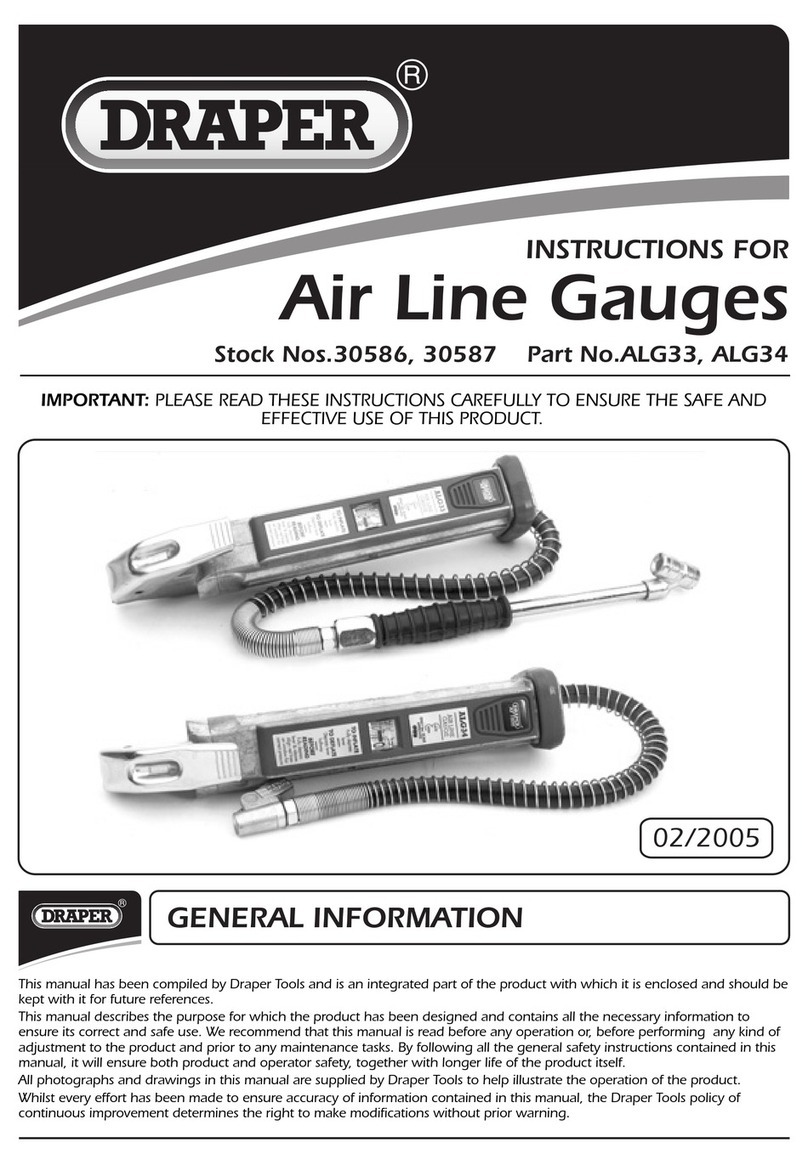
Draper
Draper ALG33 User manual
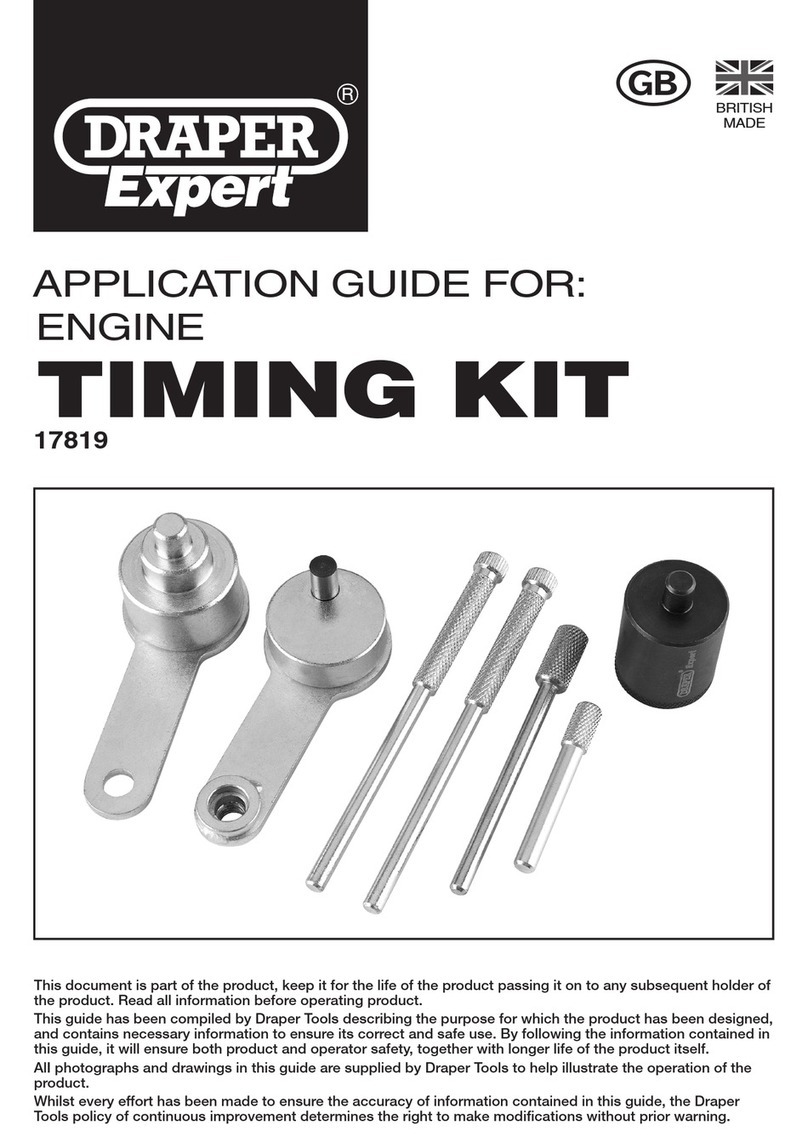
Draper
Draper 17819 User guide

Draper
Draper DTK-FORD 52576 User manual

Draper
Draper 19141 User guide

Draper
Draper 19525 User manual

Draper
Draper PJSK User manual
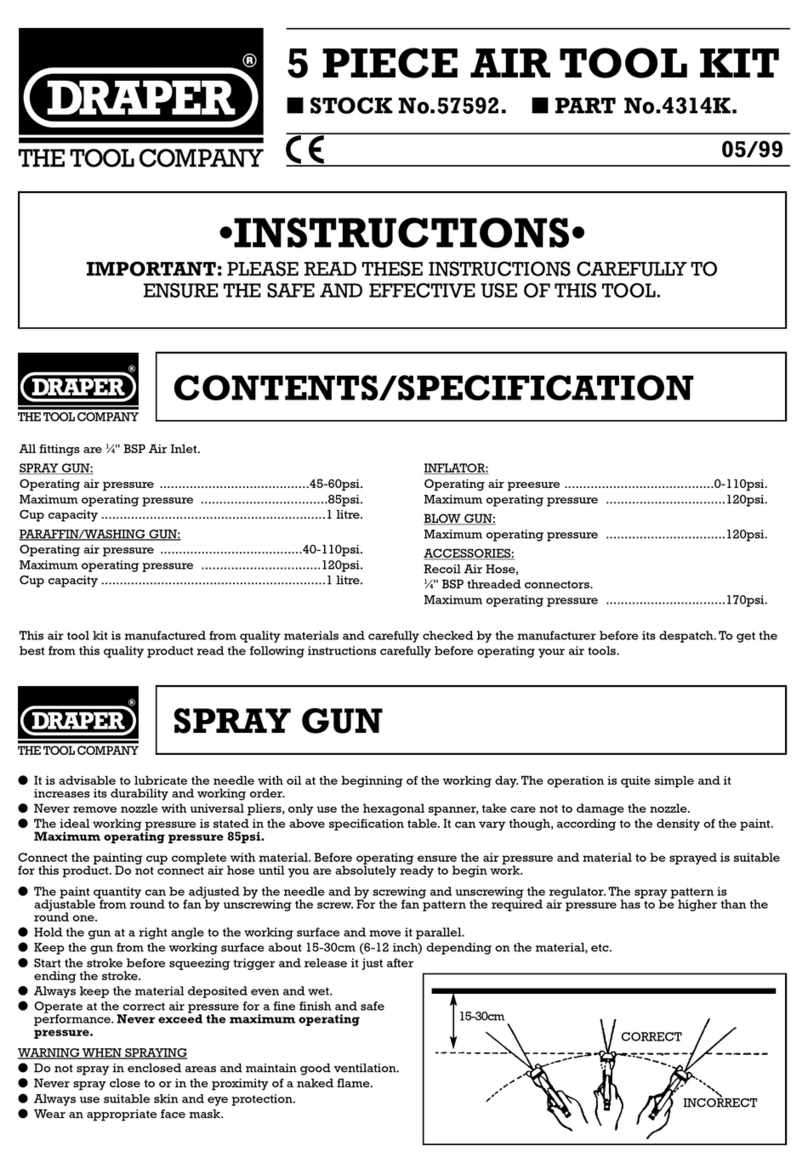
Draper
Draper 4314K User manual
